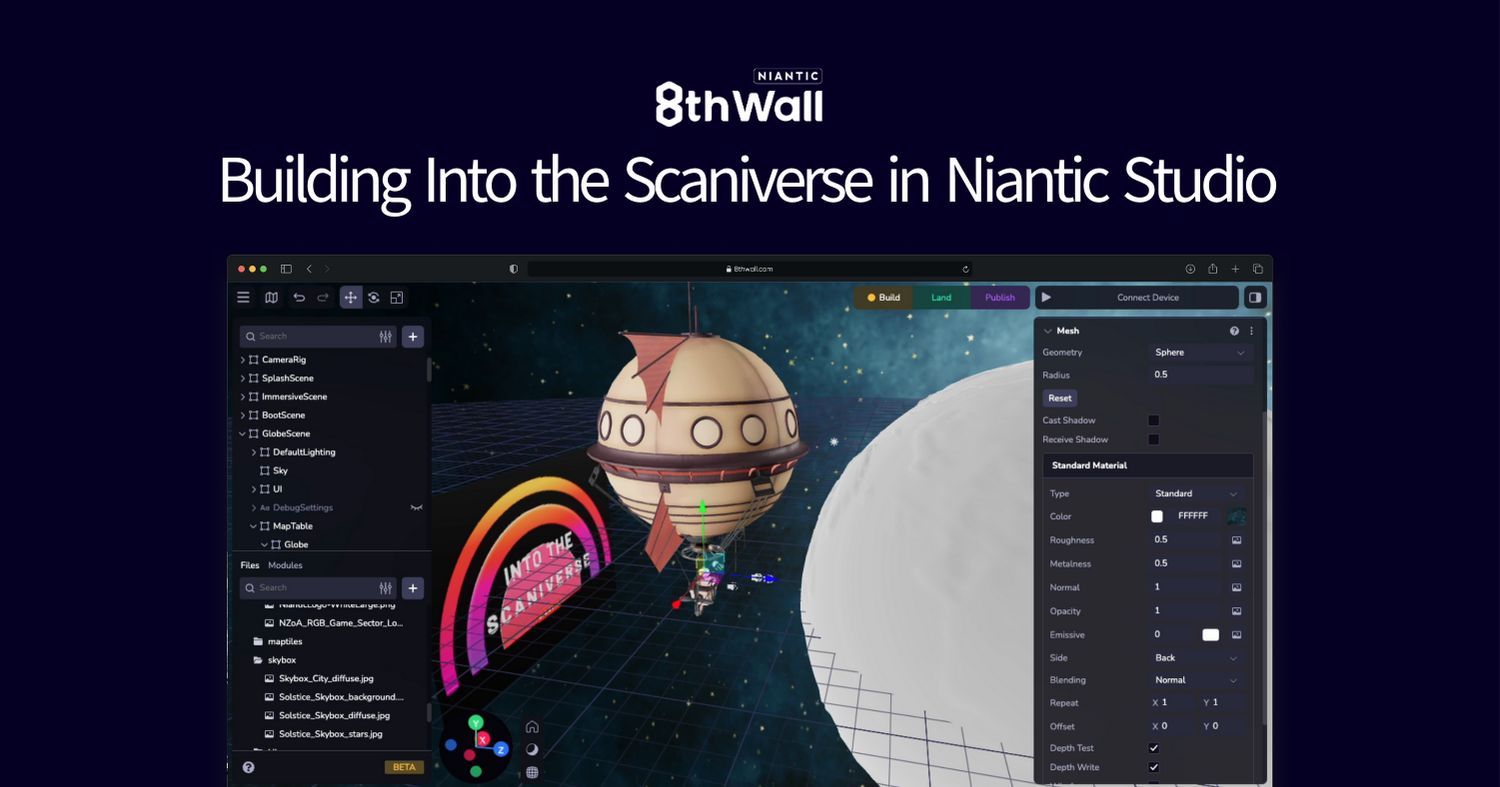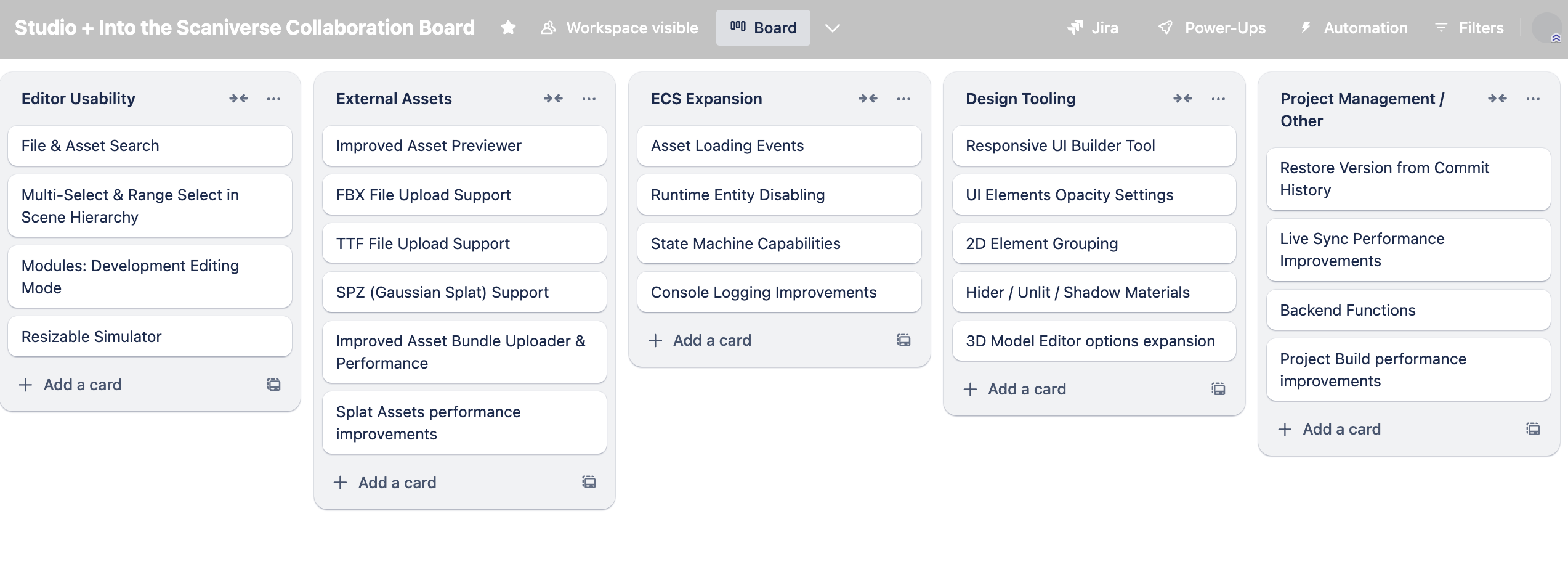8th Wall Blog
Building Into the Scaniverse in Niantic Studio
How the Niantic team built a first-of-its-kind WebXR experience for the Meta Quest browser and enabled continuous improvement of Niantic Studio in the process.

This week, our team released Into the Scaniverse, an immersive WebXR app for viewing 3D Gaussian splats captured with Niantic Scaniverse. The experience lets users explore high-fidelity, photorealistic 3D scans of the real world and interact with the environment in a way that goes beyond static visuals.
Developed entirely in Niantic Studio, this WebXR experience built for the Meta Quest browser wasn’t just a way for audiences to understand the power of splats; it was also a test of what our team could build using nothing but Niantic spatial tools, the Niantic tech stack, and Niantic Scaniverse. We’ll release the app-based version of Into the Scaniverse early next year.
Testing the limits of Niantic Studio by eating our own dogfood
From the beginning, our goal in creating this immersive experience was to test our tools and push Niantic Studio to its limits, understanding that we would likely run into issues to be fixed (aka opportunities to improve the product). To build Into the Scaniverse, the team not only had to work with the emerging technology of Gaussian splatting itself but also needed to develop using a brand new visual editing and web gaming engine just launched in public beta. It’s the definition of the tech adage “flying the spaceship as you’re building it.”
Why would we ask our team to do this? Because eating your own dogfood is the best way to build. More importantly, because we want to provide developers with the tools to build the next generation of immersive, real-world experiences. The best way to do that is to “eat our own dogfood,” or as we like to call it “eat our own ice cream.”
Building with our tools allows us to evaluate Niantic Studio through real-world use, build empathy for our developers (and understand the pains of iterating on an emerging tool), and drive continuous improvements that ensure Studio evolves alongside developer needs.
Here’s a look at what we’ve been building, what we’ve learned, and how this project is helping us make Niantic Studio the best platform for developers to build real-world immersive WebXR games and experiences.
Driving continuous improvements by uncovering the issues in a public beta platform
For many of the team working on Into the Scaniverse, Niantic Studio was a shift from working in a traditional desktop gaming engine. This perspective helped surface a lot—over 200 Jira tickets worth—of improvements we could make. Some were minor feature improvements or bug fixes needed to bring our product further out of beta, while others were critical blockers that we could only discover through developing with the tool. These changes came in areas like:
- Developer Ergonomics: Finding ways to make the code editor in Studio more intuitive, like tab management, TypeScript improvements, and console guidance.
- Front-end Ergonomics: Enhancements to the viewport, scene hierarchy, and tooltips to streamline the editing experience.
- State Machine and Events: Added improved game engine capabilities and expanded APIs and components systems to handle complex interactions.
Having the team work directly in Studio surfaced some of these ideas within weeks of Studio launching, a process that normally would take months of user feedback and support requests. This process enabled us to find, address, and roll out changes to Studio users on an ongoing basis.

Validating the power of the web through real-world use
Working on the web made collaborating quickly, testing across devices, and connecting live data easy. While coming from a desktop tool meant the team had a lot of initial feedback, it also allowed us to test the benefits of being a web-based platform live.
For example, Studio’s one-click publishing feature allowed the team to test internal versions of the app quickly and gather feedback from remote team members across Aotearoa New Zealand, California, and beyond. The connected nature of the web encouraged collaboration and ensured early versions could be stress-tested across a wide range of users.
Studio’s simulation capabilities also sped up iteration for testing across devices, enabling teams to push changes across connected devices—phones, browsers, or headsets—in seconds. Unlike traditional tools, where debugging across platforms can be time-consuming, taking anywhere from 5 to 15 minutes to land on each device, Studio connected everything back to the editor with detailed logs from each device, allowing for immediate troubleshooting.
This capability was especially impactful for VR development. Accessing headset logs is often cumbersome, requiring command-line tools or manual note-taking during tests. With Studio, the team could view logs directly in the editor, cutting down on iteration time and improving the development workflow.
These real-world tests also revealed areas for improvement, including the recently released ability to access a previous version of your project and ways to enhance Live Sync, which are now part of our roadmap.
Connecting Niantic Studio with Niantic’s scanning and mapping technologies
While building within Studio, the team also had to figure out how to connect to Niantic Scaniverse and how to render the Gaussian splats created in Scaniverse at the correct framerate.
Studio’s web-based architecture made connecting third-party APIs and services possible, but as we learned in development, we could make setting this up easier for developers. As Into the Scaniverse was under development, we released improvements to Studio’s Modules features and released backend functions capabilities. Both modules and backend functions allow Studio users to easily set up a configurable external API connection, with sensitive data such as API keys separated from the client. These types of connections in Into the Scaniverse ensure that the experience stays fresh, bringing in dynamic map updates and allowing users to easily explore amazing locations globally.
Speaking of splats, the team had a significant challenge to solve. While splats are a fantastic tool for connecting with photorealistic 3D scenes of the real world, they are also large. Their scale presented a challenge for getting them to display on a headset at the proper frame rate. When the project started, many splats rendered at less than 10 fps, which is not viable for use in VR. After much iteration, splats now render at 72 fps, enabling a comfortable, immersive experience and meeting a core requirement for the Meta Quest store.
The team used this work on splat rendering and fed it right back into Studio, shipping ongoing updates to splat rendering and performance to make it easier for developers to build with splats in Studio.
Finally, to ground the experience in the real world, the team needed a 3D globe that could zoom smoothly between bird’s -eye and city-level views. This requirement led to updates that brought more control over zoom levels, 3D navigation, and globe rendering. While initially developed for Into the Scaniverse, these updates are now being prepared for wider use by Studio developers.
What’s next for Niantic Studio and Into the Scaniverse
Into the Scaniverse is just the beginning. While there’s still more to refine, this experience demonstrates the potential of Niantic Studio and the many possibilities for developers to build and create with it.
To see what we’ve been working on, visit intothescaniverse.com in the Meta Quest browser and explore it yourself. If you’re ready to start building, jump into Niantic Studio—we’ll be there, building right alongside you.
Development of Into the Scaniverse was supported by NZ On Air through the New Zealand Game Development Sector Rebate.
.png)